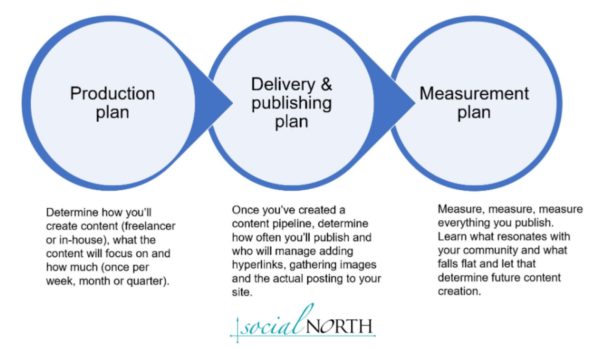What you need to know about building an effective content marketing strategy
 If facing down a global pandemic has taught us anything, it’s the power of innovative, courageous thinking. Especially for small businesses that have struggled to stay afloat while their doors are closed – or capacity is reduced.
If facing down a global pandemic has taught us anything, it’s the power of innovative, courageous thinking. Especially for small businesses that have struggled to stay afloat while their doors are closed – or capacity is reduced.
If you’re new to digital marketing – especially content marketing – it’s not too late to throw your hat in the game and start reaping the rewards. Content marketing is one of the most cost-effective ways to grow consumer engagement, improve your brand presence and, of course, drive sales. Talk about a mission-critical tool in this new world.
Simply put, content marketing begins with the creation of interesting and engaging assets (think blog posts, social media posts and images or videos) and then sharing it with an online community. The content is branded but not designed to sell – the intention is to stimulate interest and generate conversation.
Content marketing is customer-focused and answers their important questions. Well-crafted content is consistent in both cadence of publishing and it’s strong, recognizable voice (or personality) across all channels. Done right, it will allow you to reach, engage and convert customers you may have been unable to reach without a massive keyword budget.
Content consistency differentiates your voice from the masses, establishing credibility and trust, strengthening your position with every update.
How a content marketing strategy can benefit your business
1. Quality content creates trust. If your content offers something of value, people will seek you out, stick around longer and come back again and again. Think of each piece of content as an opportunity to strengthen relationships with customers (and potential customers) and reinforce your brand value. For example, if you sell barbecues, sharing for favorite burger recipes or grill cleaning tips creates an opportunity for readers to learn from you and to share your tips and tricks with their friends and family.
2. Original content improves conversions. If you’re using your blog to help consumers get more out of the products you sell, you’re empowering them to make more educated purchases. Think of the call to action (CTA) at the end of your post as an invitation for the reader to learn more – or reach out with questions. For example, if you sell TV’s, consider blog posts to help people understand menu options that can enhance their viewing experience. A CTA might be about specific settings or the difference between top selling brands.
3. Focused content helps generate leads. If your content focuses on teaching customers different ways they can use your products or services, you’ll be found more easily than your competition. Not every consumer who lands on your content is actively researching a purchase but when they’re ready to buy, you might be top of mind. What’s more, if your content is truly helpful (or funny or engaging), they’re likely to become brand advocates before even making a purchase – by sharing your content with others.
4. Inviting content creates brand loyalty. Offering your customers more than what they’ve paid for – or offering them something for free before buying – helps build trust in the marketplace. With so many businesses struggling to find their niche online, it’s noisier and more difficult to get noticed than ever before. Encouraging readers to post their pictures of the products you sell – and how they’re using them – allows your customers to be seen as influencers in their own online communities.
5. Smart content contributes to a strong SEO strategy. It’s a no-brainer but worth repeating. Quality content helps build your authority online – over your competition. And if you’re posting that content regularly – with targeted keywords – search engines will start to notice too, which will help you rank higher and higher. And sell more stuff, which is the point, right?
The bottom line is, consistent, well-crafted content will help you save money on your marketing strategy. If you’re using a freelance writer, expect to pay anywhere between $150 and $500 per post, which can be substantial for a small business. But consider what happens when you spend that same budget on Google or Facebook ads instead. Once the budget’s spent, the traffic stops. Content marketing on your website continues to attract traffic over time. And as new consumers discover it, traffic can flow through to it for years.
Do you have a content marketing strategy? The chart below will help you get started.
If you’re struggling with your digital strategy, I’d love to hear your questions and how I can help. Drop a comment below or shoot me an email and let’s start talking.
In the meantime, these posts might help you begin your content marketing journey:
- The art of editing blog posts
- Digital crisis communications
- 6 keys to writing your small business blog



Latest comments